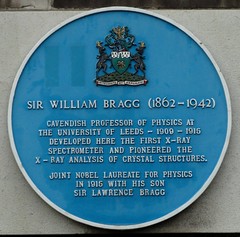Sir William Henry Bragg OM KBE PRS


Sir William Henry Bragg OM KBE PRS
(1862-1942)
developer of the first x-ray spectrometer, pioneer of the x-ray analysis of crystal structures, Nobel Physics Laureate (from 1915), Commander of the Most Excellent Order of the British Empire (1917-1920), Knight of the British Empire (from 1920), Order of Merit recipient (from 1931), and 46th President of the Royal Society (1935-1940)
Family tree
Commemorated on 3 plaques
Sir William Bragg (1862-1942) Cavendish Professor of Physics at the University of Leeds 1909-1916 developed here the first x-ray spectrometer and pioneered the x-ray analysis of crystal structures. Joint nobel laureate for physics in 1915 with his son Sir Lawrence Bragg
Parkinson Building, University of Leeds, Leeds, United Kingdom where they developed the first x-ray spectrometer
#University of Manchester
Sir Lawrence Bragg 1890-1971 Langworthy Professor of Physics at the University, 1919-1937. Nobel laureate and founder of X-ray crystallography, jointly with his father, Sir William Henry Bragg.
Coupland Street, Manchester, United Kingdom where they was
William Henry Bragg 1862-1942 Shared the Nobel Prize for Physics 1915 with his son William Lawrence. Spent time with his family here at Catherwood House throughout his early life
Catherwood House, The Square, Market Harborough, United Kingdom where they stayed



